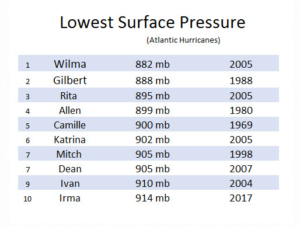By Cory Reppenhagen, KUSA -Meteorologist 9/News Colorado – 11:52 AM. MDT September 06, 2017
KUSA – You may have heard Hurricane Irma being termed the strongest hurricane to ever prowl the waters of the Atlantic Ocean, but is that technically correct?
Not really, but it all depends on how you qualify it. Those who work in the visual media, myself included, have a very short window to hold the attention of viewers, and thus terms like this get passed around without having to re-qualify those terms.
This is the case for Irma being described as the ‘strongest’ hurricane ever in the Atlantic. This is the description that should be used: Hurricane Irma has the strongest sustained winds for any hurricane in the Atlantic, excluding any hurricanes in the Caribbean or Gulf of Mexico.
This may bother some people. It bothers me personally, but it’s not a huge stretch.
Irma will end up breaking many records before it’s gone. There are some topics to discuss here though.
There is a good reason for excluding the Gulf, and the Caribbean, and there are several different ways to categorize the strength of a hurricane.
The Gulf of Mexico, and the Caribbean, are both part of the Atlantic Ocean, but it is very unusual for a hurricane to thrive in the open east Atlantic, like Irma has done. The sea surface temperatures are cooler in the open ocean between the Cape Verde Islands and the Lesser Antilles. Tropical systems are usually just organizing and maintaining as a tropical wave, a depression, tropical storm, or even a lower-strength hurricane.
That is why it is significant to note that Irma’s strength is unusual for where it was located.
Now there are several different ways to categorize the strength of a hurricane. Maximum sustained wind speed is the most popular method. In this case, Irma at 185 mph would be tied for second, with Gilbert (1988), and Wilma (2005). If you count hurricanes before 1950, you would have to throw in the Florida Keys Hurricane of 1935. Hurricane records are often referenced starting from the point in which we started naming tropical storms. Hurricane Allen in holds the record with 190 mph winds in 1980.
Another way to rank hurricane strength is with the lowest measured surface pressure. This is often described as hurricane intensity. Irma’s minimum pressure so far, is 914 millibars. That ranks it 10th in history, with Hurricane Wilma holding that title with a pressure of 882mb in October 2005.
Accumulated Cyclone Energy or ACE, is another measurement. This is a formula used to calculate the destructive energy of a storm over the course of it’s entire lifetime. It is the square of the wind speed every 6 hours, and is then scaled by a factor of 10,000 for usability.
As of Wednesday, at 10 a.m. mountain time, Irma had measured an ACE of 34.6, and that number will continue to rise over the next several days. That doesn’t get it into the top 20 for the Atlantic Basin, but it will likely get there soon. Irma is forecast to remain a major hurricane though at least Monday.
© 2017 KUSA-TV




